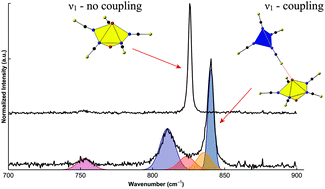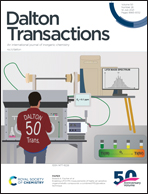Bimetallic uranyl/cobalt(ii) isothiocyanates: structure, property and spectroscopic analysis of homo- and heterometallic phases†
Abstract
We report the synthesis and characterization of a family of UO22+/Co2+ isothiocyanate materials containing [UO2(NCS)5]3− and/or [Co(NCS)4]2− building units charged balanced by tetramethylammonium cations and assembled via S⋯S or S⋯Oyl non-covalent interactions (NCIs), namely (C4H12N)3[UO2(NCS)5], (C4H12N)2[Co(NCS)4], and (C4H12N)5[Co(NCS)4][UO2(NCS)5]. The homometallic uranyl phase preferentially assembles via S⋯S interactions, whereas in the heterometallic phase S⋯Oyl interactions are predominant. The variation in assembly mode is explored using electrostatic surfaces potentials, revealing that the pendant –NCS ligands of the [Co(NCS)4]2− anion is capable of outcompeting those of the [UO2(NCS)5]3− anion. Notably, the heterometallic phase displays atypical blue shifting of the uranyl symmetric stretch in the Raman spectra, which is in contrast to many other compounds featuring non-covalent interactions at uranyl oxygen atoms. A combined experimental and computational (density functional theory and natural bond orbital analyses) approach revealed that coupling of the uranyl symmetric stretch with isothiocyanate modes of equatorial –NCS ligands was responsible for the atypical blue shift in the heterometallic phase.



 Please wait while we load your content...
Please wait while we load your content...